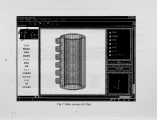| OCR Text |
Show coming from upper part of the furnace appears to overwhelm the tangential flow from the burners near the bottom of the furnace. The temperature distribution in Fig.5 also suggests the dominance of an axial downward flow. High temperature region is limited near the burners. Since the axial downward flow is dominant, the flames are not created tangentially on the honzontal cross section at the height of respective burners. The zonal control of muffle temperature appears rather complicated with the conventional burner system. Fig.6 shows the predicted temperature distribution on the muffle surface. To express the temperature distribution on the cylindrical surface on a 2-dimensional plain, the height and radial direction of the muffle are transposed to the vertical and horizontal axes in Fig.6, respectively. The temperature profile is expressed by the color contours. Since the muffle is more likely to be heated near burners that are allocated vertically in-line, the temperature distribution shows a striped pattern. This nonuniform distribution of muffle temperature is expected to cause serious problems to the muffle such as thermal stress and associated deformation and destruction. Fig.7 shows the predicted heating curve of the steel strip. Dots ( # ) indicate the prediction with an empirical 1-dimensional method. Three lines show predicted heating curves at three different locations across the cross section of the steel strip. The predicted heating curves show that the temperature of the steel strip is higher at the edge than in the center during the heating process and the temperature gradually becomes uniform as the heating process proceeds to completion with a final temperature up to 1400K after approximately one minute of heating. A good agreement is observed between the present prediction and the 1 - dimensional method. Since the empirical 1-dimensional method has been used widely with reasonable reliability to design furnaces, the agreement between the present prediction and the 1-dimensional method is encouraging. The present 3-dimensional method has been proved to be not only compatible with the empirical 1-dimensional method but also capable of predicting detailed information such as the distribution of temperature and velocity. The present method can be used extensively to optimize the furnace design and performance in more detail. 5. FDI regenerative burner system 5.1 Analytical model Fig.8 shows three different analytical models used for the optimization of the FDI regenerative burner system. These models represent a part of the full-scale furnace. Each model is equipped with three pairs of the F D I regenerative burners. The figure shows one of the two combustion modes of a regenerative system. Three burners are in the firing m o d e with the other three being in the flue mode. Tests on applying the FDI regenerative burner system to box-shaped reheating furnaces 5 |




















